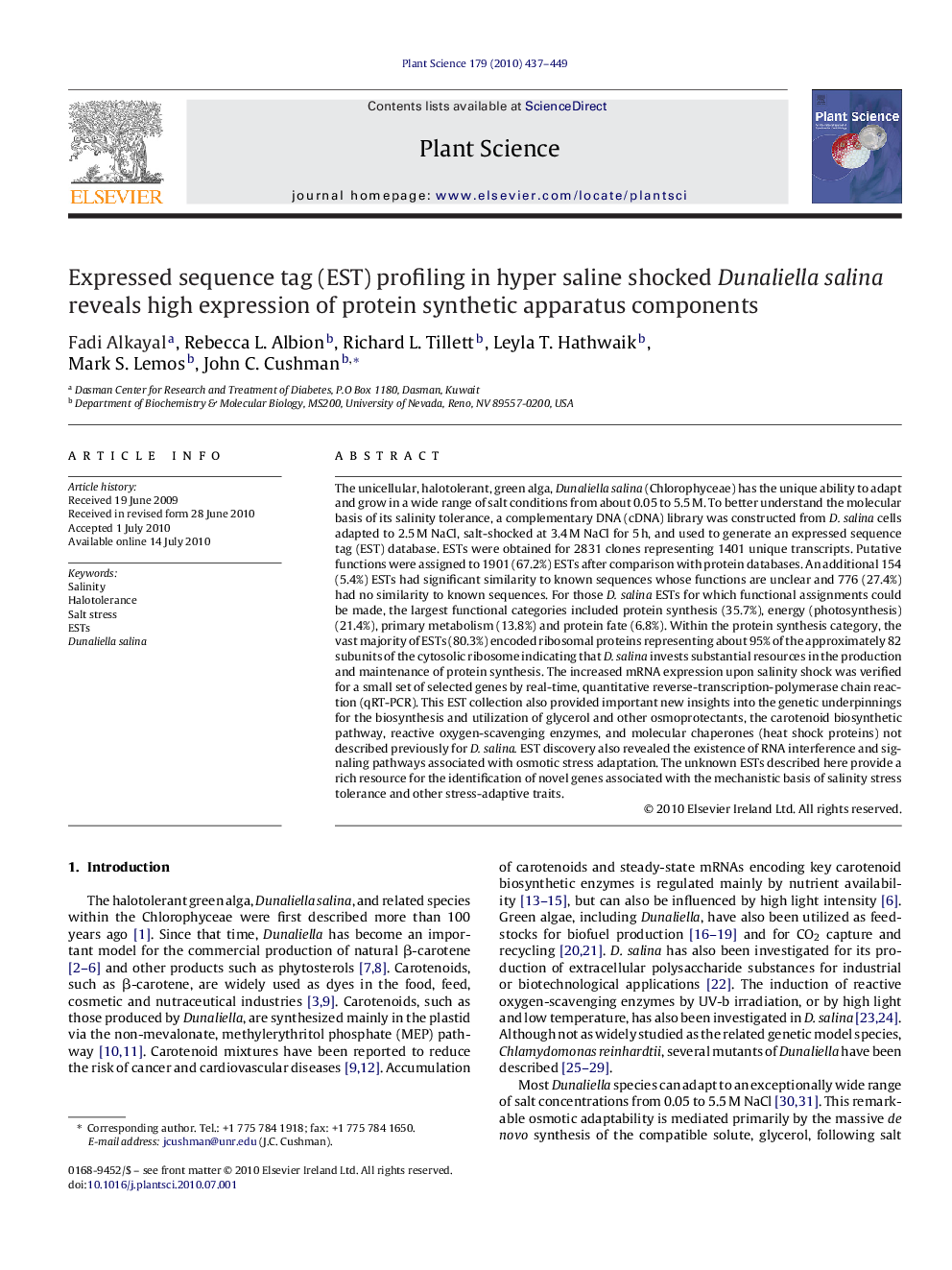| کد مقاله | کد نشریه | سال انتشار | مقاله انگلیسی | نسخه تمام متن |
|---|---|---|---|---|
| 2017600 | 1067806 | 2010 | 13 صفحه PDF | دانلود رایگان |

The unicellular, halotolerant, green alga, Dunaliella salina (Chlorophyceae) has the unique ability to adapt and grow in a wide range of salt conditions from about 0.05 to 5.5 M. To better understand the molecular basis of its salinity tolerance, a complementary DNA (cDNA) library was constructed from D. salina cells adapted to 2.5 M NaCl, salt-shocked at 3.4 M NaCl for 5 h, and used to generate an expressed sequence tag (EST) database. ESTs were obtained for 2831 clones representing 1401 unique transcripts. Putative functions were assigned to 1901 (67.2%) ESTs after comparison with protein databases. An additional 154 (5.4%) ESTs had significant similarity to known sequences whose functions are unclear and 776 (27.4%) had no similarity to known sequences. For those D. salina ESTs for which functional assignments could be made, the largest functional categories included protein synthesis (35.7%), energy (photosynthesis) (21.4%), primary metabolism (13.8%) and protein fate (6.8%). Within the protein synthesis category, the vast majority of ESTs (80.3%) encoded ribosomal proteins representing about 95% of the approximately 82 subunits of the cytosolic ribosome indicating that D. salina invests substantial resources in the production and maintenance of protein synthesis. The increased mRNA expression upon salinity shock was verified for a small set of selected genes by real-time, quantitative reverse-transcription-polymerase chain reaction (qRT-PCR). This EST collection also provided important new insights into the genetic underpinnings for the biosynthesis and utilization of glycerol and other osmoprotectants, the carotenoid biosynthetic pathway, reactive oxygen-scavenging enzymes, and molecular chaperones (heat shock proteins) not described previously for D. salina. EST discovery also revealed the existence of RNA interference and signaling pathways associated with osmotic stress adaptation. The unknown ESTs described here provide a rich resource for the identification of novel genes associated with the mechanistic basis of salinity stress tolerance and other stress-adaptive traits.
Research highlights▶ ESTs were obtained for 2831 clones representing 1401 unique transcripts form the unicellular, halotolerant, green alga, Dunaliella salina (Chlorophyceae) exposed to salt shock (3.4 M NaCl) for 5 h. ▶ Putative functions were assigned to 1901 (67.2%) ESTs after comparison with protein databases, whereas an additional 154 (5.4%) ESTs had significant similarity to known sequences whose functions are unclear and 776 (27.4%) had no similarity to known sequences. ▶ For those D. salina ESTs for which functional assignments could be made, the largest functional categories included protein synthesis (35.7%) with the vast majority of ESTs (80.3%) encoded ribosomal proteins representing about 95% of the approximately 82 subunits of the cytosolic ribosome indicating that D. salina invests substantial resources in the production and maintenance of protein synthesis. ▶ EST discovery revealed the existence of new genes for biosynthesis and utilization of glycerol and other osmoprotectants, the carotenoid biosynthetic pathway, reactive oxygen-scavenging enzymes, and molecular chaperones, and the RNA interference and signaling pathways associated with osmotic stress adaptation.
Journal: Plant Science - Volume 179, Issue 5, November 2010, Pages 437–449